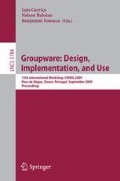Abstract
Ubiquitous computing integrates Internet/Intranet small integrated sensors as well as powerful and dynamic devices into the people’s working and domestic areas. An intelligent area contains many devices that provide information about the state of each artifact (e.g., power failure of the refrigerator) without user intervention. Service discovery systems are essential to achieve this sophistication as they allow services and users to discover, configure and communicate with other services and users. However, most of these systems only provide support for interaction between services and software clients. In order to cope with this limitation, the SEDINU system aims at supporting interactions between nomadic users and services provided by areas. As users may move within the organization from an area to another one in order to accomplish their tasks, this system also provides support for user-user interaction and collaboration under specific contexts (role, location and goals).
Access this chapter
Tax calculation will be finalised at checkout
Purchases are for personal use only
Preview
Unable to display preview. Download preview PDF.
References
Adjie-Winoto, W., Schwartz, E., Balakrishnan, H., Lilley, J.: The Design and Implementation of an Intentional Naming System. In: Proc. of SOSP 1999, The 17th ACM Symposium on Operating System Principles, December 12-15, pp. 186–201. ACM Press, Charleston (1999)
Campo, C., Almenarez, F., Diaz, D., Garcia-Rubio, C., Lopez, A.M.: Secure Service Discovery based on Trust Management for ad-hoc Network. Journal of Universal Computer Science 12(3), 340–356 (2006)
Chang, C.-Y., Sahoo, P.K., Lee, S.-C.: A Location-Aware Routing Protocol for the Bluetooth Scatternet. Wireless Personal Communications: An International Journal 40(1), 117–135 (2007)
Edwards, W.K.: Discovery Systems in Ubiquitous Computing. IEEE Pervasive Computing 5(2), 70–77 (2006)
Garcia, K., Mendoza, S., Decouchant, D., Olague, G., Rodriguez, J.: Shared Resource Availability within Ubiquitous Collaboration Environment. In: Briggs, R.O., Antunes, P., de Vreede, G.-J., Read, A.S. (eds.) CRIWG 2008. LNCS, vol. 5411, pp. 25–40. Springer, Heidelberg (2008)
Han, J., Cho, Y., Kim, E., Choi, J.: A Ubiquitous Workflow Service Framework. In: Gavrilova, M.L., Gervasi, O., Kumar, V., Tan, C.J.K., Taniar, D., Laganá, A., Mun, Y., Choo, H. (eds.) ICCSA 2006. LNCS, vol. 3983, pp. 30–39. Springer, Heidelberg (2006)
Herborn, S., Lopez, Y., Seneviratne, A.: A Distributed Scheme for Autonomous Service Composition. In: Proc. of the First ACM Int. Workshop on Multimedia Service Composition, November 6-11, pp. 21–30. ACM Press, Singapore (2005)
Jamalipour, A.: The Wireless Mobile Internet: Architectures, Protocols and Services. John Wiley & Sons, Inc., New York (2003)
Jeronimo, M., Weast, J.: UPnP Design by Example: A Software Developer’s Guide to Universal Plug and Play. Intel Press, Hillsboro (2003)
Labiod, H., Afifi, H., De Santis, C.: Wi-Fi, Bluetooth, ZigBee and WiMax, 1st edn. Springer, Dordrecht (2007)
Nidd, M.: Service Discovery in DEAPspace. IEEE Personal Communications 8(4), 39–45 (2001)
Oaks, S., Wong, H.: Jini in a Nutshell: A Desktop Quick Reference. O’Reilly & Associates, Inc., Sebastopol (2000)
White, K.M.: Apple Training Series Mac OS x Support Essentials, 2nd edn. Peachpit Press, Berkeley (2008)
Zhao, W., Schulzrinne, H.: Enhancing Service Location Protocol for Efficiency, Scalability and Advanced Discovery. Journal of Systems and Software 75(1-2), 193–204 (2005)
Zhu, F., Mutka, M.W., Ni, L.M.: Service Discovery in Pervasive Computing Environments. IEEE Pervasive Computing 4(4), 81–90 (2005)
Zhu, I.H., Chlamtac, I.: Admission Control and Bandwidth Reservation in Multi-hop ad hoc Networks. Computer Networks 50(11), 1653–1674 (2006)
Author information
Authors and Affiliations
Editor information
Editors and Affiliations
Rights and permissions
Copyright information
© 2009 Springer-Verlag Berlin Heidelberg
About this paper
Cite this paper
Gómez, V., Mendoza, S., Decouchant, D., Rodríguez, J. (2009). Nomadic User Interaction/Cooperation within Autonomous Areas. In: Carriço, L., Baloian, N., Fonseca, B. (eds) Groupware: Design, Implementation, and Use. CRIWG 2009. Lecture Notes in Computer Science, vol 5784. Springer, Berlin, Heidelberg. https://doi.org/10.1007/978-3-642-04216-4_3
Download citation
DOI: https://doi.org/10.1007/978-3-642-04216-4_3
Publisher Name: Springer, Berlin, Heidelberg
Print ISBN: 978-3-642-04215-7
Online ISBN: 978-3-642-04216-4
eBook Packages: Computer ScienceComputer Science (R0)

